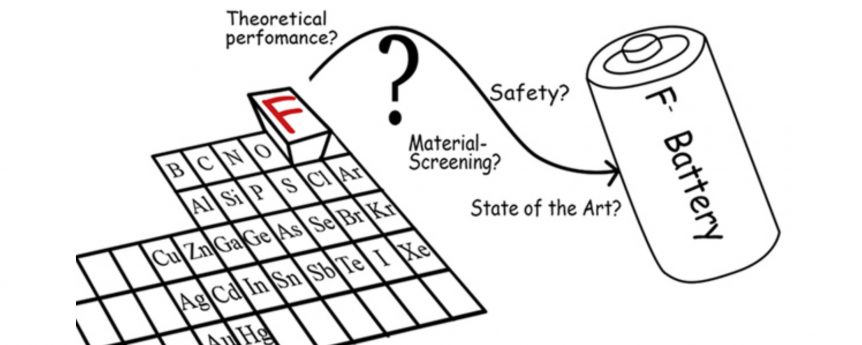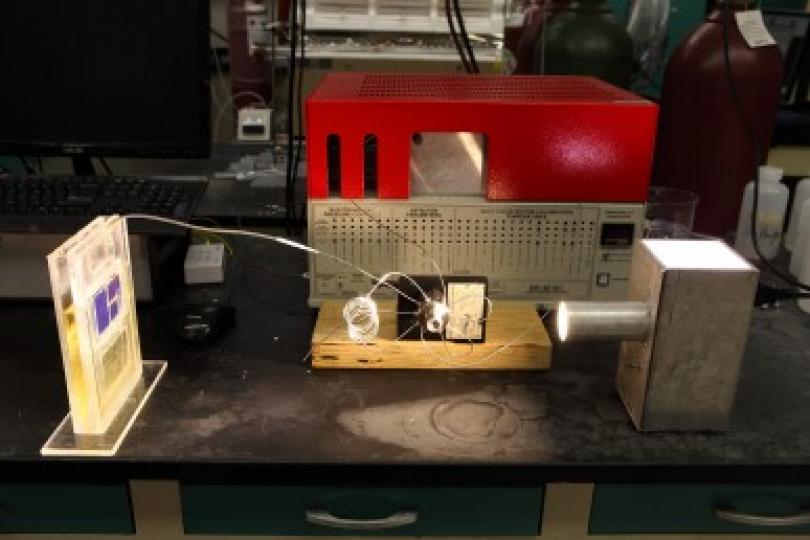Can the stuff that protects your teeth find happiness storing electrical energy? Researchers are brushing up on their chemistry to produce a fluoride battery – almost the total opposite of a lithium battery. Three years ago, The Journal of Fluorine Chemistry quibbled, “Only a handful of publications exist on the topic of fluoride ion batteries (FIBs). These are electrochemical cells in which a negative anion—fluoride—enables charge transport. In this review, we will report, for the first time, an extensive theoretical screening of FIBs as well as an analysis of the safety and toxicity of electrochemical couples of such batteries.” It continued with an exploration of high-temperature (150° C, or 302° F) and room-temperature examples of fluoride cells and ended with comparisons of seven different cathode and nine different anode materials “to further illustrate the potential and issues of such battery systems.” Now, Honda, researchers from the California Institute of Technology (CalTech), NASA’s Jet Propulsion Laboratory and a scientist now at …
Lithium-Oxygen Battery Breakthrough
The University of Waterloo (Ontario, Canada – not far from Niagara Falls) News, reported, “Chemists make breakthrough on the road to creating a rechargeable lithium-oxygen battery.” Dr. Linda Nazar, Canada Research Chair in Solid State Energy Materials, led a team that “Resolved two of the most challenging issues surrounding lithium-oxygen batteries, and in the process created a working battery with near 100 per cent coulombic efficiency.” The new work, which appears this week in the journal Science, Proves that four-electron conversion for lithium-oxygen electrochemistry is highly reversible.” Waterloo is the first to achieve this, doubling electron storage in lithium-oxygen (Li-O2 – also known as lithium-air) batteries. The video below touches on this and a great many other chemistries. Dr. Nazar explains, “There are limitations based on thermodynamics. Nevertheless, our work has addressed fundamental issues that people have been trying to resolve for a long time.” As noted in the abstract for the Science paper, when Dr. Nazar and her colleagues …
Photosynthesis Directly Makes Fuel
That’s what photosynthesis does in leaves – creates fuel in the form of plant sugars that flow into the plant to which the leaf is attached. One of the main quibbles about trying to convert solar energy to usable fuel is the usual multi-step process involved. Researchers at the University of Illinois at Chicago have made a major advance in creating a solar cell that captures carbon dioxide (CO2) and uses sunlight to make a synthetic gas that can be burned as fuel. Scientists rarely use hyperbolic terms such as “extraordinary” in their findings. According to Amin Salehi-Khojin, assistant professor of mechanical and industrial engineering at UIC, “What we needed was a new family of chemicals with extraordinary properties.” They may have found that family, but their discovery is buried in the less grandiose phrasing of their paper’s abstract in the July 29 issue of Science. “Small and salty CO2 reduction scheme” That might sound like part of the secret …
Daniel Nocera Returns to the Artificial Leaf
Many scientists are turning to mimicking nature to probe its secrets, but Daniel Nocera, the Patterson Rockwood Professor of Energy at Harvard University, has gone far beyond his natural model. Reported in 2012, Nocera came up with the idea of an “artificial leaf,” a silicon sheet with a layer of cobalt-based catalyst that releases oxygen on one side and a layer a nickel-molybdenum-zinc alloy on the other side that releases hydrogen. Several researchers have followed this initial breakthrough, trying different materials and combinations of ingredients. For a while, it looked as though Nocera turned his attention to battery development, but recent news shows he’s back investigating artificial leaves – with great improvements over his initial efforts – and those of nature, it would seem. His newest approach combines the catalytic energy of the original leaf with a bacterium that makes useful fluids out of the hydrogen generated. It makes the leaf’s output a practical liquid – a fuel. It probably …
Cambridge’s “Ultimate” Battery? Wait 10 Years and See
Cambridge University researchers claim to have successfully demonstrated how several of the problems impeding the practical development of the so-called “ultimate” battery, in this case a lithium-oxygen unit, could be overcome. They make some pretty impressive claims, saying they’ve developed a working laboratory demonstrator with “very high” energy density – comparable to that of gasoline and with greater than 90-percent efficiency, and the ability to be recharged more than 2,000 times, or 5-1/2 years with a complete cycle and recharge every day. A lithium-oxygen or lithium-air battery of this type would allow an uninterrupted drive between London and Edinburgh on a single charge, about 415 miles, over 100 miles greater than the top mileages promised by Tesla and GM at this point. Researchers add the promise of one-fifth the cost and one-fifth the weight of currently available batteries – a touchstone for electric aircraft designers, and close to the goals U. S. Energy Secretary Steven Chu asked for three years …
More Powerful, Longer Lasting Perovskites
Perovskites, calcium titanium oxide minerals composed of calcium titanate, with the chemical formula CaTiO, are found in relative abundance throughout the world and have characteristics that make them a plausible candidate for use in solar cells. Initially showing good efficiency at small scales, perovskite solar cells were potentially less expensive to produce than conventional silicon-based units, and could be more efficient, especially as single-layer silicon cells reach their theoretical limit of 30-percent efficiency. Perovskite cells could be configured to respond to different wavelengths of light, stacked on one another, and still be thinner than conventional solar cells. Part of the attraction of perovskites cells has been their rapid increase in efficiency, nearly equaling the best silicon cells in about six years, as opposed to the 35 years needed for silicon cells to increase from 16 percent efficiency to a little over 25. Some factors get in the way, one being that perovskites react badly with moisture. Thus, their life spans are much shorter than the more …
Combining the Best Features of Balsa Wood, Ceramics and NERF®
California Institute of Technology (CalTech) floats this imaginary trial balloon to elicit interest in a new material developed by materials scientist Julia Greer and her colleagues. “Imagine a balloon that could float without using any lighter-than-air gas. Instead, it could simply have all of its air sucked out while maintaining its filled shape. Such a vacuum balloon, which could help ease the world’s current shortage of helium, can only be made if a new material existed that was strong enough to sustain the pressure generated by forcing out all that air while still being lightweight and flexible.” Not only are the scientists achieving the strong, lightweight part of the equation, they are “on the path” to making their new material “non-breakable” and able to return to its original size and shape when squished. As described in her talk shown above, she and her group turned to architectural solutions, only making their bridge-like trusses at the nano scale – where things …
Cheap Hydrogen, Anyone?
Researchers in Glasgow and at Stanford University have devised ways to decouple oxygen and hydrogen from water without resort to expensive extraction or storage techniques. Both breakthroughs involve low-cost materials, low-energy requirements, and the production of clean hydrogen through what should be renewable energy resources. The latter overcomes one major objection to hydrogen production. As Professor Lee Cronin of the University of Glasgow’s School of Chemistry explains, “Around 95% of the world’s hydrogen supply is currently obtained from fossil fuels, a finite resource which we know harms the environment and speeds climate change. Some of this hydrogen is used to make ammonia fertilizer and as such, fossil hydrogen helps feed more than half of the world’s population. “The potential for reliable hydrogen production from renewable sources is huge. The sun, for example, provides more energy in a single hour of sunlight than the entire world’s population uses in a year. If we can tap and store even a fraction of …
Taking That Fork in the Solar Road
Kyoung-Shin Choi, a chemistry professor at the University of Wisconsin-Madison, and postdoctoral researcher Tae Woo Kim combined forces to come up with a two-pronged approach for producing stored energy from mere sunlight. Many researchers take the familiar path of using expensive materials to extract the greatest percentage of energy from solar cells, but others use low-cost, less efficient organic materials spread across a greater area to get the same results. Choi and Kim, though, decided that selecting two different low-cost materials could give greater results – something a more single-path approach would miss. As their U of W report states, “Generating electricity is not the only way to turn sunlight into energy we can use on demand. The sun can also drive reactions to create chemical fuels, such as hydrogen, that can in turn power cars, trucks and trains.” The expensive semiconductors and catalysts normally used to transform sunlight to fuels are “far too expensive” to make competitive sun fuel possible, …
Making Graphene and Carbon Fibers Even Lighter and Stronger
While scientists at Columbia University have used chemical vapor deposition (CVD) to create large sheets of stronger-than-average graphene, a research team at Massachusetts Institute of Technology (MIT) has found ways to weave stronger carbon nanotubes. James Hone and Jeffrey Kysar, professors of mechanical engineering at Columbia University, learned that the enormous strength of graphene is usually achieved in only small patches. The “grain boundaries” for larger sheets were often far weaker than the theoretical strengths of which the material is capable. That strength is phenomenal. Hone explains, “It would take an elephant, balanced on a pencil, to break through a sheet of graphene the thickness of Saran Wrap.” Results of their study were published in the journal Science. The paper’s lead author, Gwan-Hyoung Lee, a postdoctoral fellow in the Hone lab, says, “Our findings clearly correct the mistaken consensus that grain boundaries of graphene are weak. This is great news because graphene offers such a plethora of opportunities both for …




